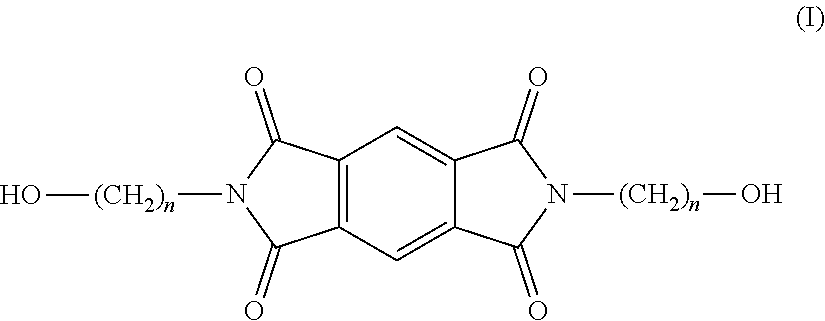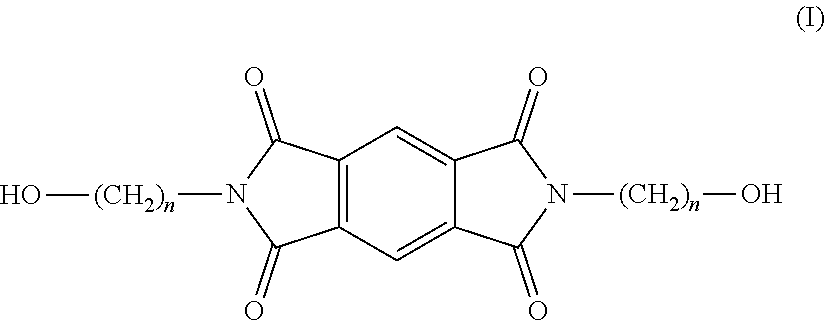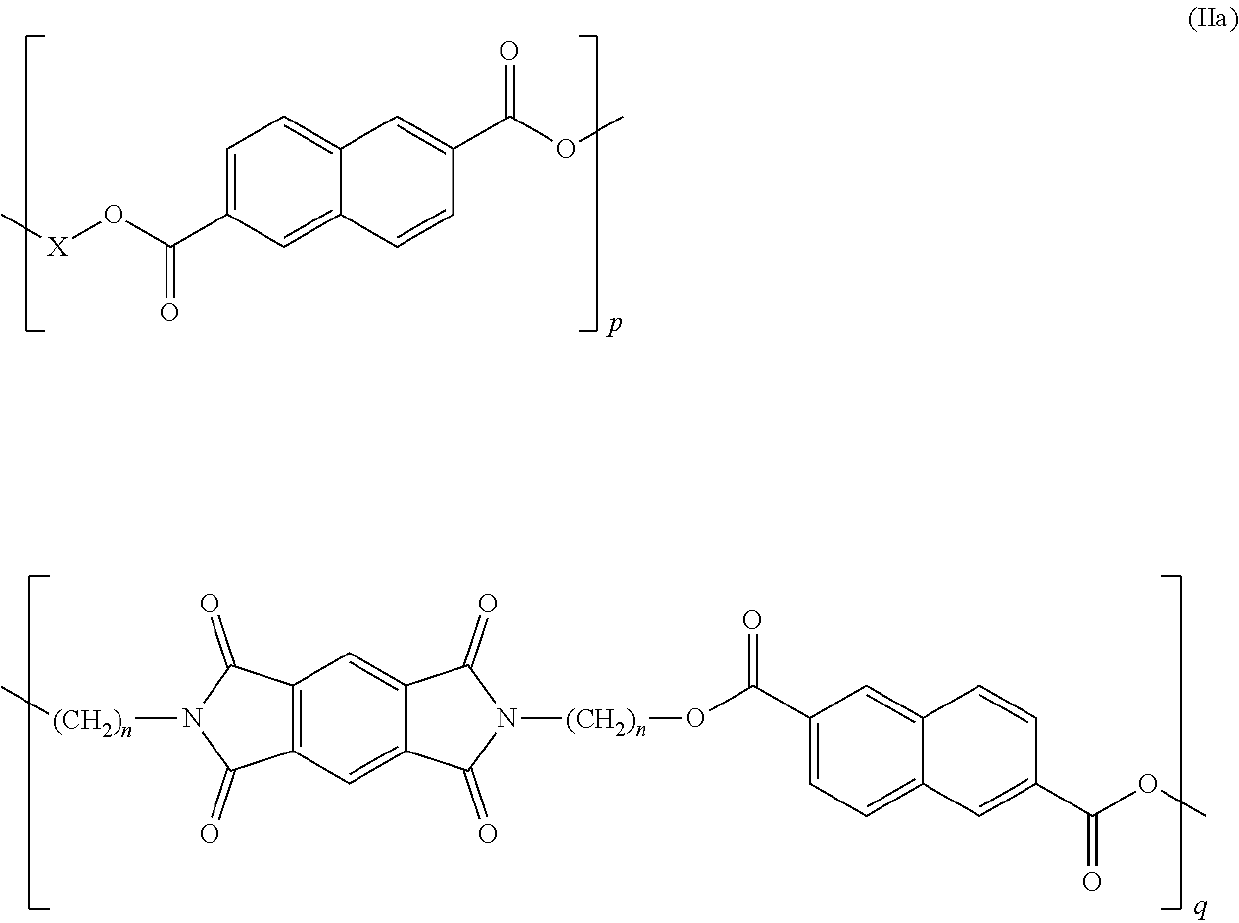Copolyesterimides derived from n,n'-bis-(hydroxyalkyl)-pyromellitic diimide and films made therefrom
- Summary
- Abstract
- Description
- Claims
- Application Information
AI Technical Summary
Benefits of technology
Problems solved by technology
Method used
Image
Examples
example 1
of (Monomer 1)
[0085]
[0086]Ethanolamine (1.70 mL, 27.56 mmol) was added to a mixture of pyromellitic dianhydride (3.01 g, 13.80 mmol), DMAc (25 mL) and toluene (15 mL). The reaction mixture was then refluxed overnight, using a Dean-Stark apparatus to azeotropically distil off the co-produced water. The reaction mixture was cooled to room temperature and poured into water (˜400 mL) upon which a white precipitate formed. The suspension was stirred for 6 h, filtered, and the solid was washed with water and MeOH and dried under vacuum at 100° C. overnight to produce 3.72 g of N,N′-bis-(2-hydroxyethyl)-pyromellitic diimide as an off-white powder (yield: 89%; mp (DSC): 283° C.; MS m / z=327.0589 [M+Na], calculated 327.0545, 1H NMR (400 MHz, DMSO) δ (ppm) 8.22 (4H, m, Hb+c), 7.97 (2H, d, J=8.16 Hz, Ha), 4.85 (2H, t, J=12.0 Hz, Hf), 3.67 (4H, t, J=11.3 Hz, Hd), 3.59 (4H, m, Hf); 13C NMR (100 MHz, DMSO) δ (ppm) 167.48 (C7+8), 144.00 (C1), 137.17 (C3), 132.75 (C4), 131.42 (C6), 123.53 (C2), 121....
examples 2 to 11
Copolyesters
[0087]Two series of novel linear poly(ester-imide)s were synthesised, by polycondensation between either bis-(2-hydroxyethyl)-terephthalate (BHET) or bis-(2-hydroxyethyl)-2,6-naphthalate (BHEN) and the comonomer of formula (I). Copolymers containing varying amounts of co-monomer were obtained using Sb2O3 or GeO2 as catalyst. Transesterification was carried out under vacuum at 190-200° C. over ca. 30-90 minutes, followed by a polycondensation stage at 290-300° C. The polymers were soluble in TFA and / or HFIP, and in mixtures of either TFA or HFIP with CHCl3. Re-precipitation in MeOH gave white or off-white polymer beads which were isolated by filtration, washed with methanol and dried.
[0088]The general polyesterification procedure, illustrated for PET, is as follows: bis(2-hydroxyethyl) terephthalate (BHET, 5.01 g, 19.71 mmol) and Sb2O3 (1.50 mg, 4.12×103 mmol) were charged to a Schlenk tube fitted with a rubber-sealed stirrer guide and a glass stirrer rod. The reaction mi...
example 2
5
[0091]1H NMR (400 MHz, CDCl3:TFA (2:1)) δ (ppm) 8.40 (s, Hf), 8.17 (s, Ha), 8.10 (s, He), 4.84 (s, Hb), 4.70 (s, Hd), 4.29 (s, He), 13C NMR (100 MHz, CDCl3:TFA (2:1)) 167.85 (C1), 166.98 (C10), 137.09 (C1), 133.31 (C2), 133.11 (C6), 130.05 (C3), 119.33 (C12), 63.92 (C4), 63.50 (C8), 37.67 (C9), Tg=88° C., Tcc=170° C., Tm=243° C., Tc=156° C., ηinh=0.58 dL g−1.
PUM
| Property | Measurement | Unit |
|---|---|---|
| Fraction | aaaaa | aaaaa |
| Temperature | aaaaa | aaaaa |
| Temperature | aaaaa | aaaaa |
Abstract
Description
Claims
Application Information
 Login to View More
Login to View More - R&D
- Intellectual Property
- Life Sciences
- Materials
- Tech Scout
- Unparalleled Data Quality
- Higher Quality Content
- 60% Fewer Hallucinations
Browse by: Latest US Patents, China's latest patents, Technical Efficacy Thesaurus, Application Domain, Technology Topic, Popular Technical Reports.
© 2025 PatSnap. All rights reserved.Legal|Privacy policy|Modern Slavery Act Transparency Statement|Sitemap|About US| Contact US: help@patsnap.com



